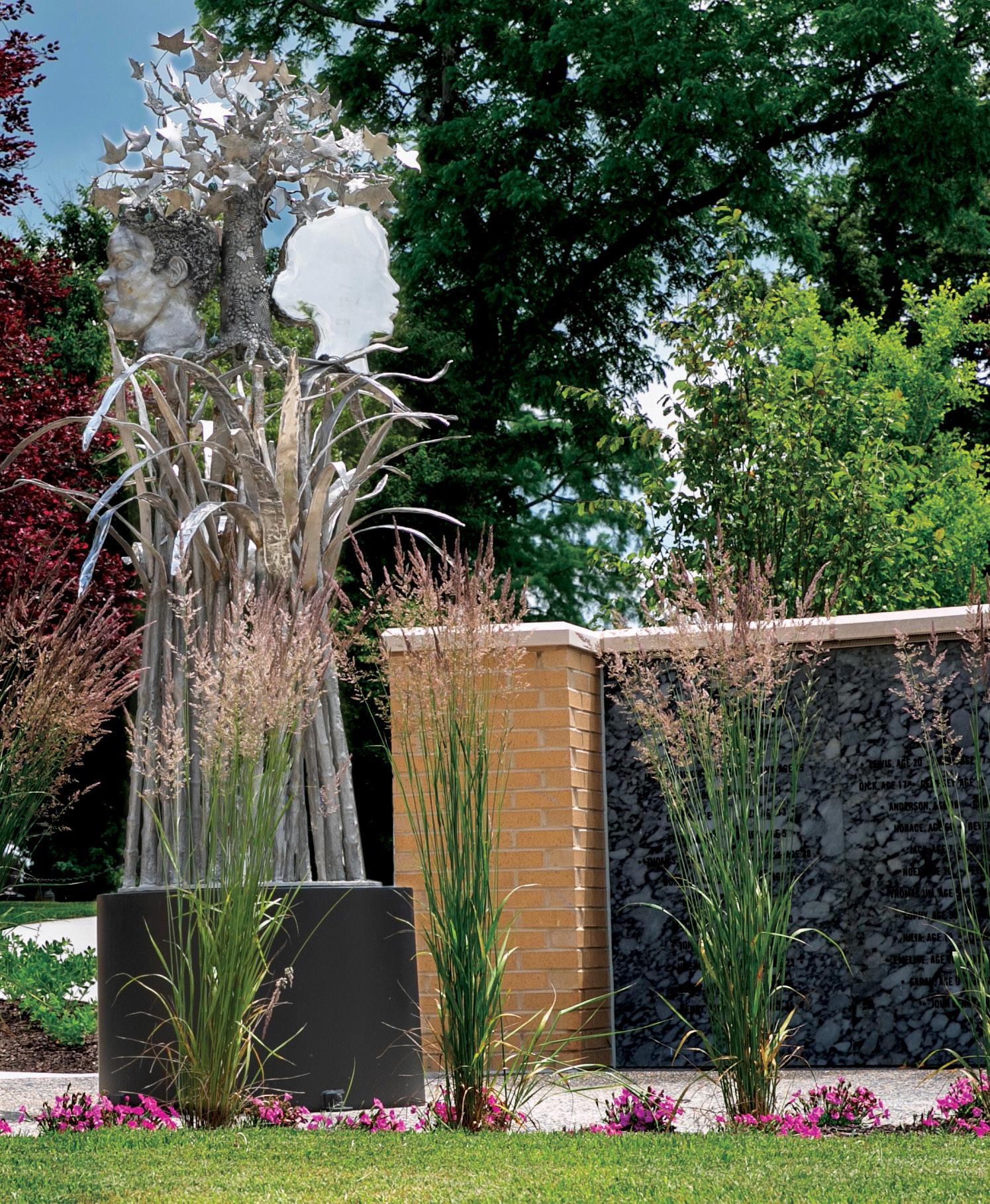
7 minute read
THE MEMORIAL TO THOSE ENSLAVED AND FREED
JOURNEY TO UNDERSTANDING
BY MEREDITH BOWER
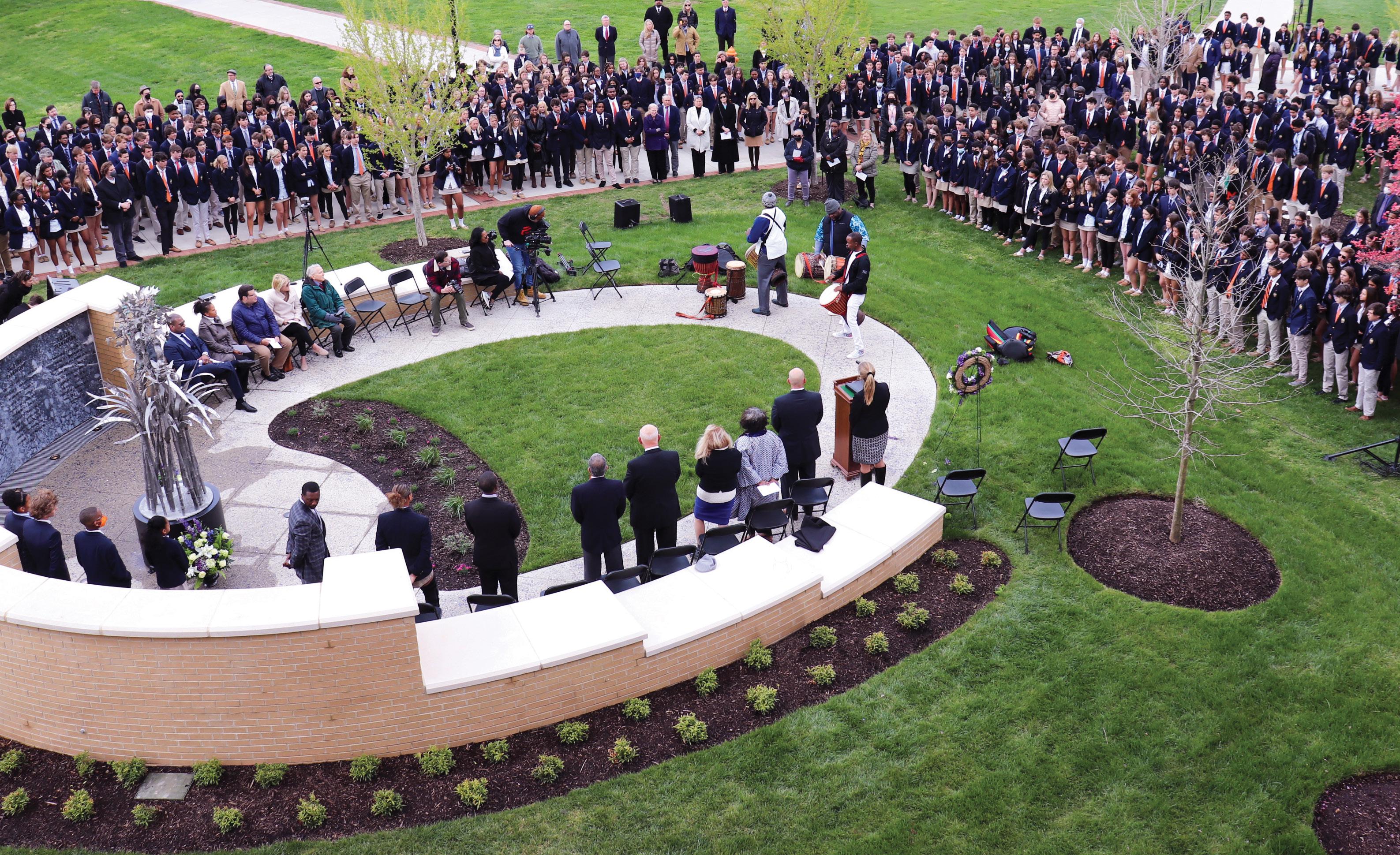
When The Memorial to Those Enslaved and Freed was dedicated in a ceremony on April 19, students watching in person and via livestream felt a confluence of emotions. “It made me feel sad, happy, and proud,” one fourth grader recalls. His emotions were mirrored by young and old.
The event—and a similar ceremony for alumni during Reunion Weekend—featured African drumming, a traditional libation ceremony, the reading of the enslaved people’s names engraved on the memorial walls, and the tolling of the bells in Tagart Chapel. Students from prekindergarten through twelfth grade understood the significance of the ceremony thanks to a series of age-appropriate lessons taught in advance of the event.
Understanding McDonogh’s Connection to Slavery
Teaching about slavery is a daunting task, especially for teachers of elementary students for whom there is little guidance nationally on the best practices for approaching the subject in age-appropriate ways. In anticipation of the dedication, Bridget Collins ’90, The Charles W. Britton Director of Character and Service; Kevin Costa, Director of Innovation and Learning; and Stasha Gibbs, then Interim Director of Equity and Inclusion, developed a series of thoughtfully created lessons for students in all three divisions, designed to provide an understanding of the Memorial and the history around it.
Collins recalls that when she was a student in the late 1980s, on the rare occasions that John McDonogh was mentioned, he was referred to as a businessman. “I had no knowledge that he was an enslaver,” she says. When she returned as a history teacher a decade after her graduation, the narrative had changed slightly. It was said that he owned plantations in New Orleans, was a member of the American Colonization Society, and that he was “a man of his time.” Only by taking a deeper look was it clear that a large portion of his wealth was the result of his role as a slave trader and the labor of those who he enslaved on his plantations. Collins notes that until this year, there
was no schoolwide curriculum about the School’s founder and his role in slavery. Teaching about John McDonogh was siloed and addressed by a handful of passionate faculty members, including second-grade teacher Nancy Lewis (who conceived the idea for a memorial to the enslaved) and Upper School art teacher Oletha DeVane (who was commissioned to create the Memorial). Both have since retired.
Collins says things began to change six years ago when history classes looked at Founder’s Day and asked “how can we be more transparent in teaching Upper School kids about John McDonogh and his involvement with slavery?” After studying ship logs, letters from David McDonogh (a freed slave), and other primary scources, a curriculum began to evolve, and in 2020, Founder’s Day gave way to Dedication Day.
“McDonogh is an institution that remembers, and it is our moral imperative to honor and remember the enslaved people whose labor made our school possible,” says Head of School Dave Farace ’87. “It is also our responsibility to acknowledge the past and embrace the complex lessons that our history teaches us.”
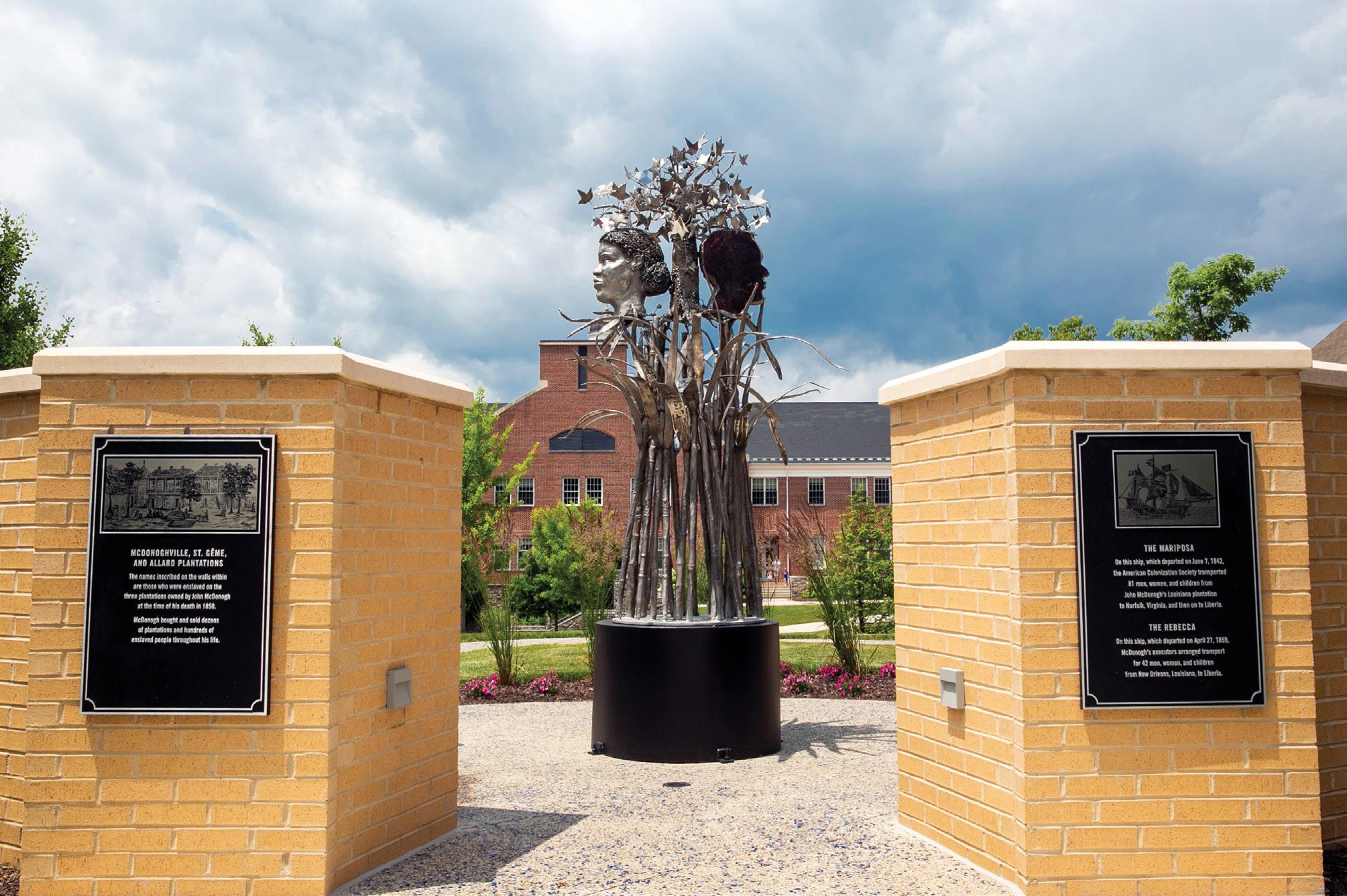
The plaques at the entrance to the memorial garden contain information about John McDonogh’s plantations in New Orleans and the ships that transported the manumitted people from the plantations to Liberia.
Lessons Give the Memorial Context
Throughout the early spring as site work for the Memorial was underway outside, faculty were building a foundation of understanding in classrooms across campus. The four distinct lessons, designed to provide critical context for better understanding the School’s history and the purpose of the Memorial, were carefully vetted and tweaked to ensure that they were appropriate for each division and grade level.
In the first lesson on representing identity, students learned why and how symbols, crests, and other imagery represent the identities of groups and individuals. Then they came up with symbols that represented their advisory and created a seal that represented their group. “The feedback was great,” Collins says, noting that it was a bonding activity. “It was about community and how we represent self. It left students asking, ‘how do we make sure all people are represented and what does it feel not to be a part of that?’”
This learning set the stage for the second lesson on how groups and institutions choose to memorialize people and why remembering is important. Teachers focused on how the School uses memorials to teach the values about which we care deeply. Students understood the difference between the statue of John McDonogh, which marks his grave, and the Memorial to the Enslaved and Freed—public art designed with walls to sit on and a garden in which to remember, reflect, learn, and question.
The third lesson, on John McDonogh’s role as a slaveholder, was the most complex in terms of adapting the content for a wide range of ages. The team turned to then-incoming Director of Equity and Inclusion Enaye Englenton for advice on how to educate lower schoolers. She suggested that rather than focusing on the brutality of slavery, to focus on fairness and the character values of kindness and respect—concepts young children understand. In the end, each slightly unique lesson addressed basic foundational questions: What does it mean to be free? Is it fair not to be free? Is it fair not to be paid for the work you do, to not be able to go where you want to go, or to be made to work from sun up to sun down in difficult circumstances?
The final lesson, which took place shortly before the dedication ceremony, featured artist Oletha DeVane, who spoke to the school community via video about the various features of the Memorial and the symbolism.
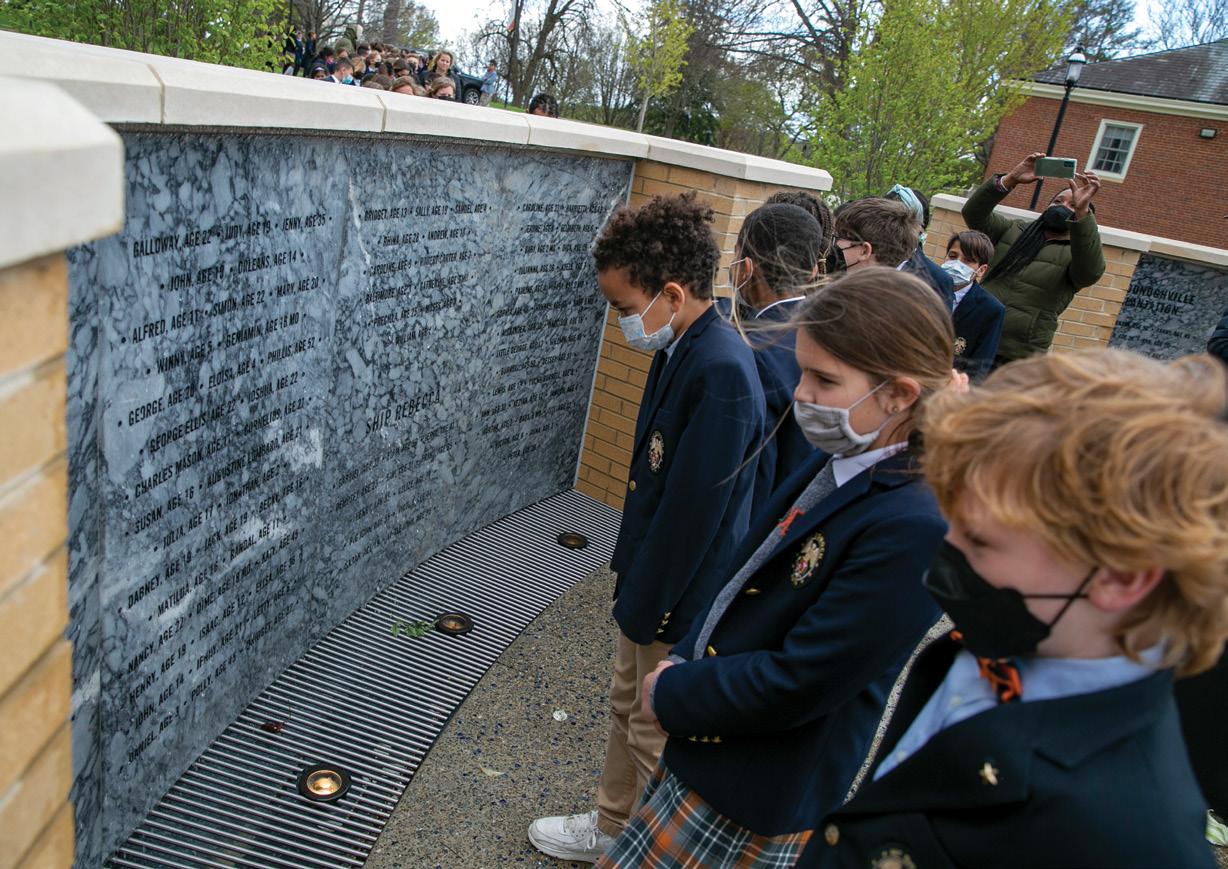
After watching the schoolwide ceremony via livestream, Lower and Middle School students have their first opportunity to interact with The Memorial to Those Enslaved and Freed.
Dedication is the Beginning
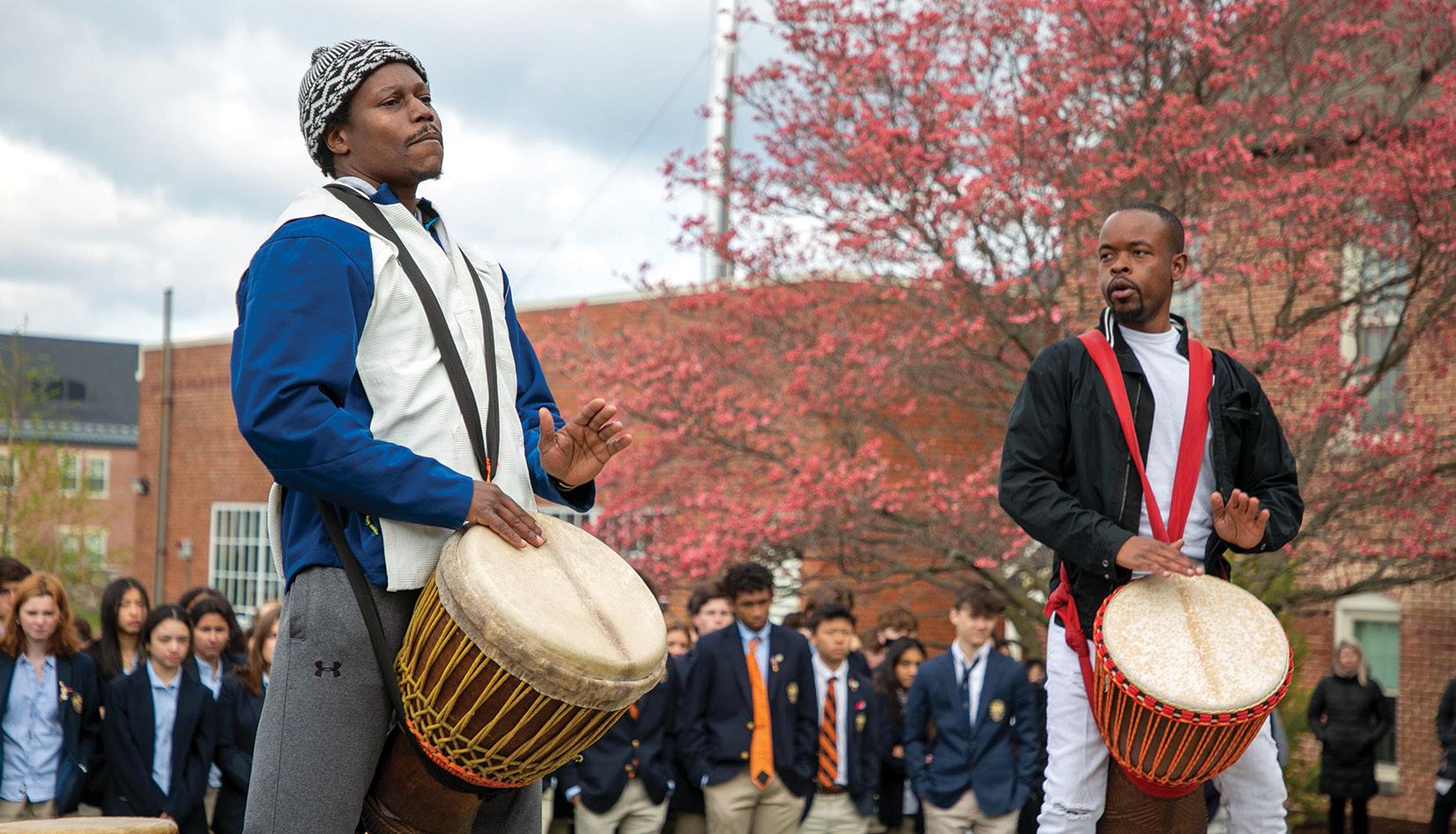
The ceremonies dedicating the Memorial to Those Enslaved and Freed featured traditional West African drumming by Baltimore-based Urban Foli.
Collins, Costa, and Gibbs believe the lessons were an essential part of dedicating the Memorial. “The ceremony was beautiful, and the ritual was very moving and healing,” Collins says.
“The kids understood why we were remembering, and they felt proud that we were remembering. That to me was the most important part of the whole journey.” She explains, “These children will never be a part of an institution that didn’t acknowledge its ties to slavery. Their life and experience at McDonogh will be one of transparency and honesty.”
Collins continues, “It’s difficult, but it’s our history. So much of not talking about this is the fear that we are somehow shaming people into feeling guilty about a past they had nothing to do with. There wasn’t any shame. Students were proud of who we are now. There was sadness because it’s a sad and tragic part of our history. They felt empowered by the notion that there is power in speaking people’s names and remembering. That is something that is so quintessentially McDonogh.”
While the journey to the creation of the Memorial to those Enslaved and Freed has concluded, Farace is quick to note that the education will continue. He says, “The road to the creation of this meaningful space has ended, but the path to understanding goes on. This memorial offers countless opportunities for reflection and learning. I hope that everyone in our school community will spend time here and remember those whose forced labor paved the way for each one of us to make a positive difference in the world.”
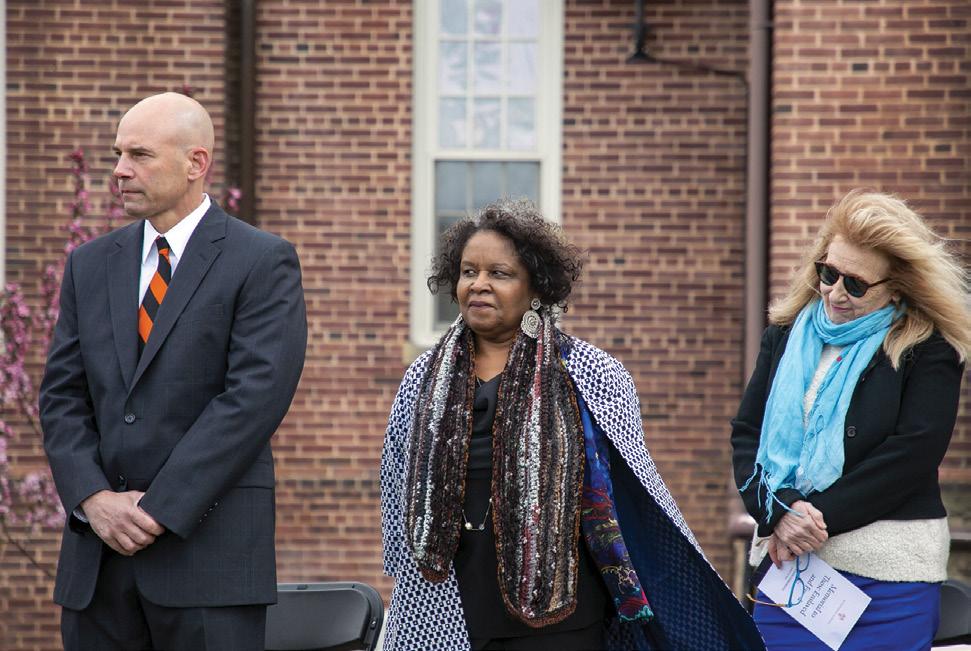
Head of School Dave Farace ’87, memorial artist and retired Art Department Chair Oletha DeVane, and retired Lower School teacher Nancy Lewis—whose idea was the inspiration for the memorial—listen as the names of the enslaved people are read.
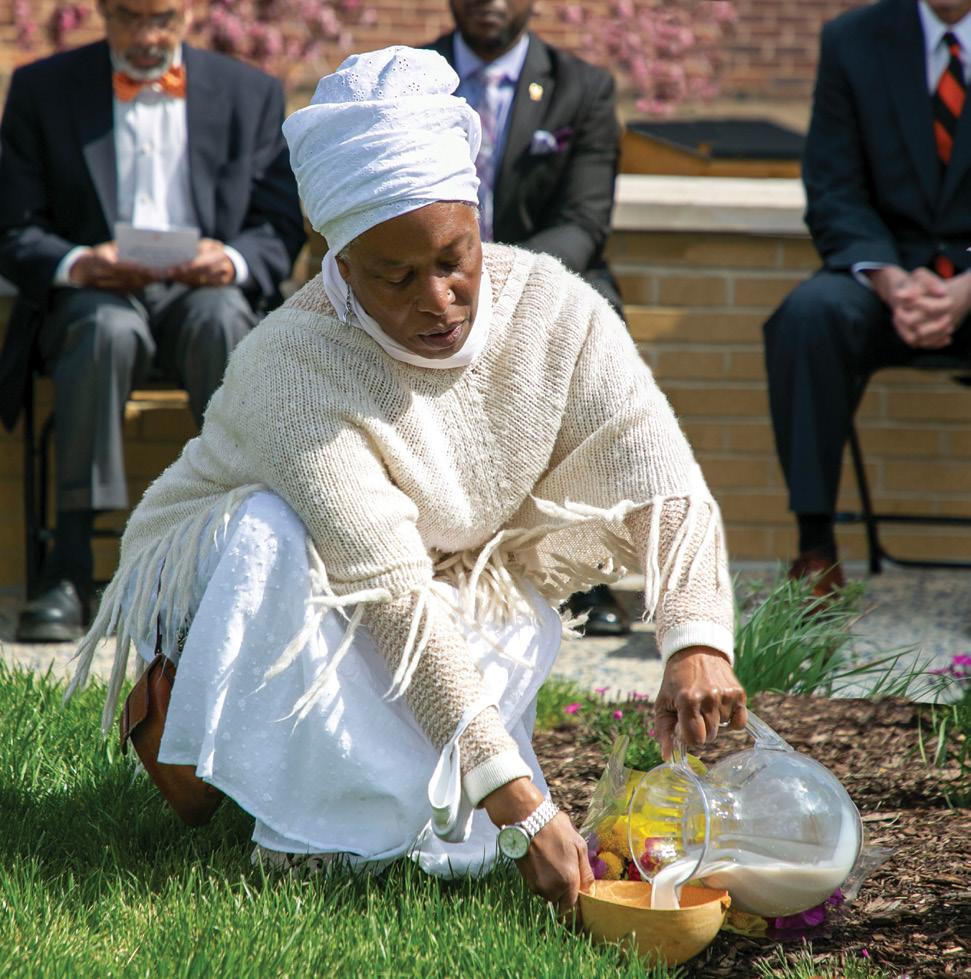
Retired faculty member Efia Dalili conducts a libation ceremony—a sacred tradition in which the pouring of water is an offering to ancestors and honors those who have passed away.
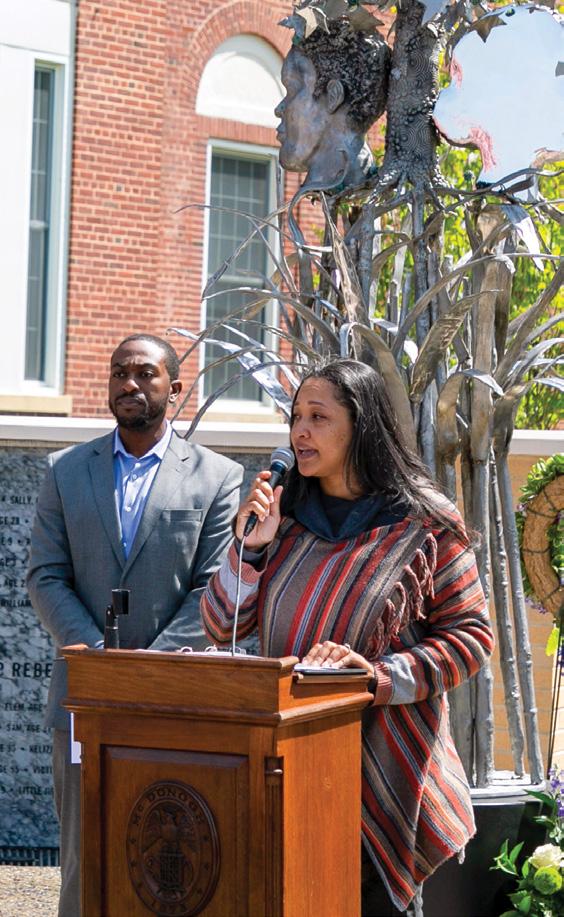
Niela Magwood-Phoenix ’96, Co-Chair of the DEI Committee of the Alumni Board, and Alumni Association President Josh Thomas ’06 read the names of the enslaved inscribed on the walls of the Memorial at the dedication ceremony during Reunion Weekend.
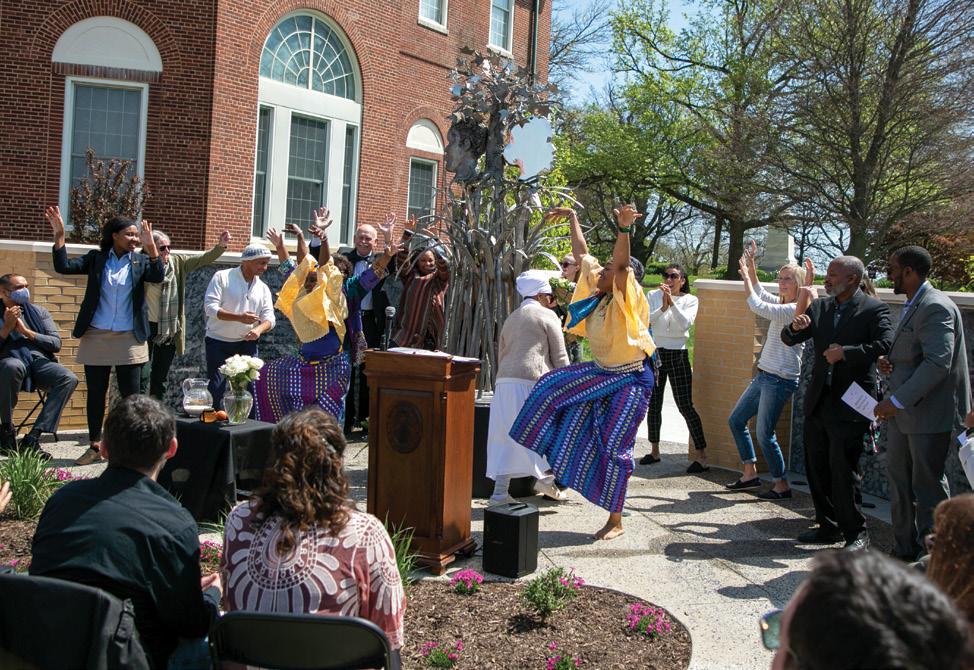
West African dancers Brenda Brown and Danielle Hinton engage the audience in traditional dance at the alumni dedication ceremony.
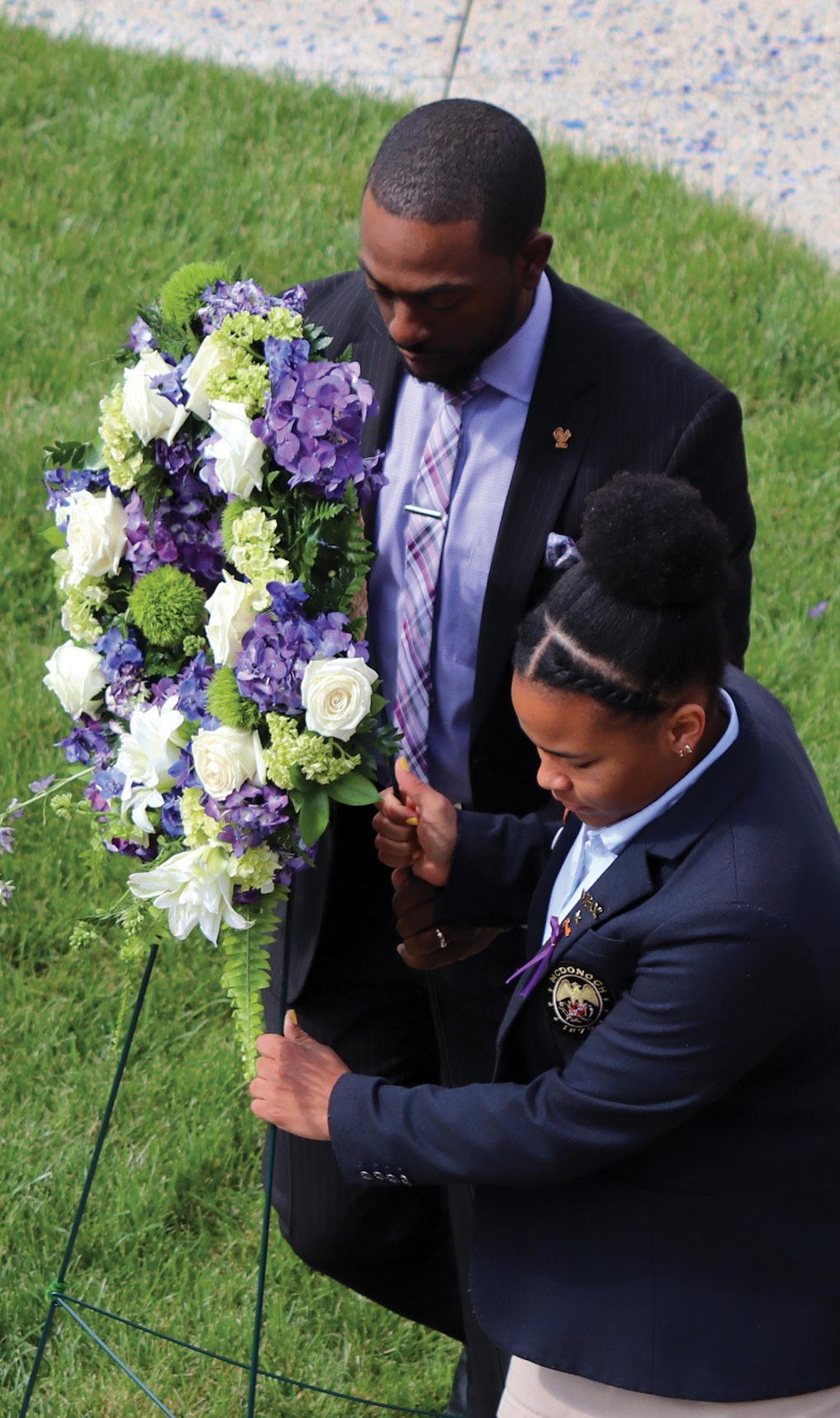
Alumni Association President Josh Thomas ’06 and Senior Class President Sydney Smith ’22 place a wreath during the schoolwide dedication. Similarly, Alumni Association Vice President Caitlin Xenakis ’07 and David Holland ’90, the Co-Chair of the Alumni Board’s Black Alumni Committee, placed a wreath at the Reunion Weekend dedication ceremony.
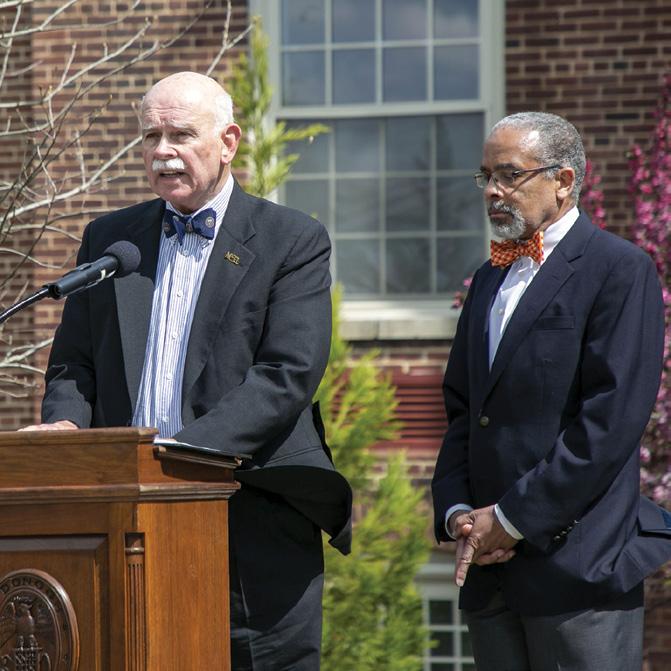
John Grega and Curtis Adams ’84, two of the original committee members who sought a way to recognize and honor the enslaved people of John McDonogh, read the names of enslaved men, women, and children etched on the Memorial walls. They were joined by retired Lower School teacher Nancy Lewis, President of the Alumni Association Josh Thomas ’06, and Senior Class President Sydney Smith ’22 at the schoolwide dedication ceremony.










